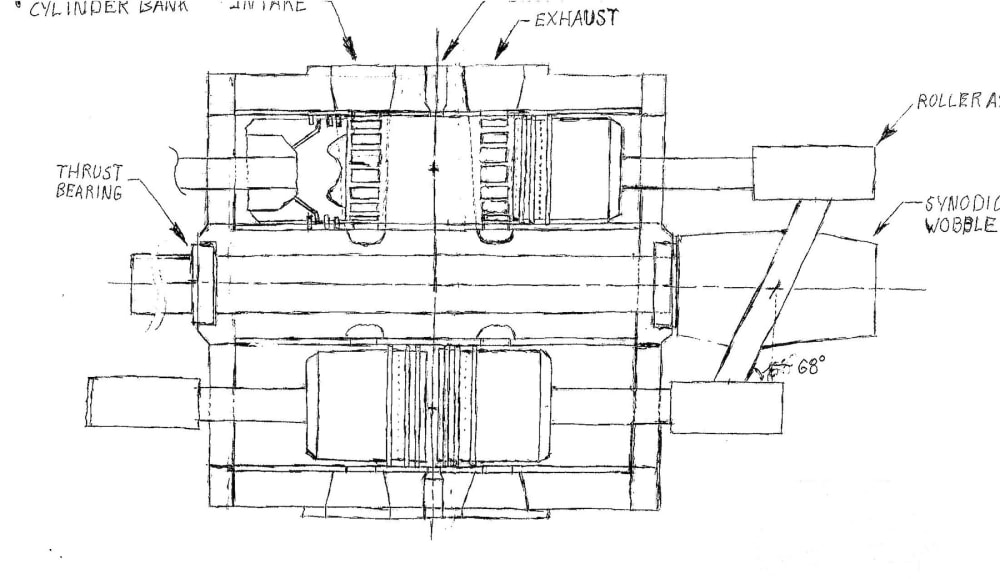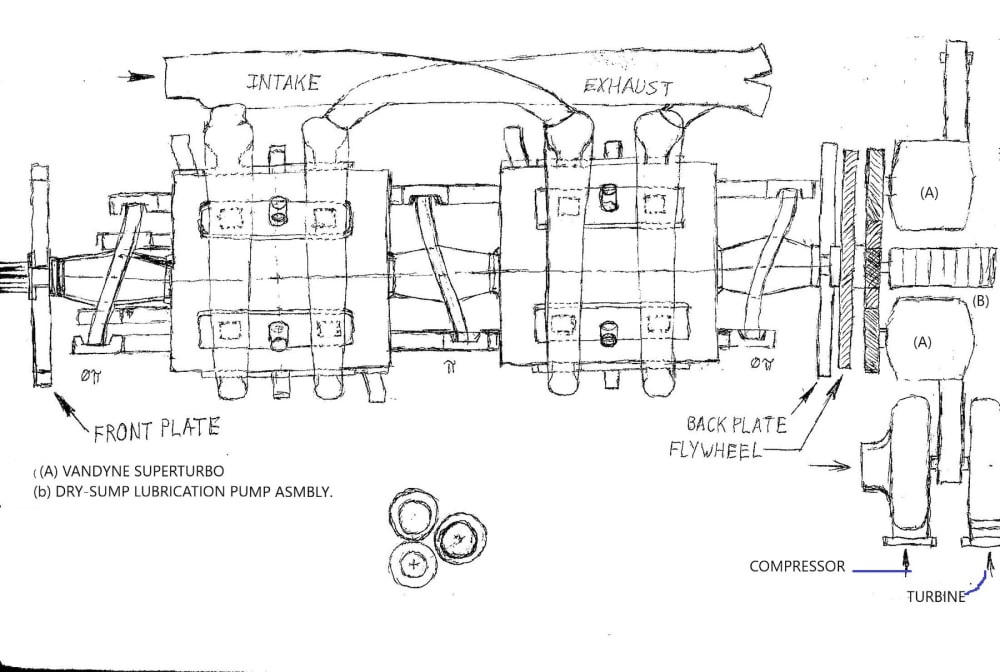The AxOPOC Engine is a hybridization of the EcoMotors’ EM-Series Opposing Piston Opposing Cylinder engine, and a sinusoidal-cam wobble-plate engine (aka. Revolver-cam/Dynacam engine). In this case, the inner two pistons share a common wobble-plate which is π-radians (180) out of phase with the end capping wobble-plates (and thicker than its counter-parts to deal with the greater forces acting upon it), which each accommodate a single piston, and needing guide-rods to maintain proper contact with the cam-plate. As with all sinusoidal-cam wobble-plates, the pistons are connected by a twin-roller assembly that rides on the rim of the cam, transferring the mechanical energy. This greatly reduces the mechanical complexity of linkages, and friction (by approximately 40%) due to eliminating side-forces on the pistons, hinge-pins, and connecting rods. As an opposing piston engine, each cylinder shares two pistons and is a 2-stroke engine, where each piston serves as a valve for both intake and exhaust, thus there is no head to disperse heat energy, and both pistons convert expanding gas into linear-mechanical-energy. Here the sinusoidal-cam wobble-plate converts that linear energy into rotational motion. The engine uses ceramic-thermal-barrier coatings on the piston faces, exhaust-ports, and exhaust-manifolds to improve thermodynamic efficiency, to reduce heat losses, and reduce cooling system load. The engine’s cylinder-assemblies are cast using lost-foam method out of compacted graphite-iron, and use a wet-sleeve design. This allows CNC milling of the cooling, induction, and exhaust channels. Lubrication is via dry-sump system with oil-cooling, using spray nozzles targeting the piston-back and cylinder, wobble-plate and piston-roller-linkage, and lubrication of the thrust bearings; with multiple sumps in each wobble-plate area at 120 intervals. The induction system uses a version of the computer-controlled Vandyne Superturbo with an intercooler. The advantage of its multi-mode operation initially functioning as a supercharger, then once exhaust pressure becomes sufficient takes over powering the compressor from the engine as a turbocharger, and ultimately returning any surplus power back to the crankshaft through turbocompounding. The direct-mechanical interface to the engine where a roller-based constantly-variable-transmission using a ‘traction-fluid’ prevents the compressor from over-speeding, and reducing the output speed matching the engine with less energy losses than a fluid-coupling.
Some of the advantages of this engine coming from the OPOC elements of the design are: 90% cylinder scavenging, 40% less NO2 emissions, at least 48% (possibly up to 58%) Carnot thermodynamic efficiency (which results in improved fuel economy), the cylinders move half the distance of a standard diesel (roughly 0.8335 of the bore), a 1.1 to 1 power to weight ratio, and each set of cylinders with on oil-consumption of 0.2 g/kw/h (likely translating to 1.2 g/kw/h). Some benefits from the sinusoidal-cam are: 40% less friction than standard boxer-style engines, smoother operation allowing for a range of from 150 to 3500 revolutions per minute with minimum vibration, lower manufacturing cost due to have up to 50% fewer parts, smaller physical size, and further improvements to the power to weight ratio and energy density. I see the fuel-consumption being directly proportional to engine speed.
Like this entry?
-
About the Entrant
- Name:Jeff Kavanaugh
- Type of entry:individual
- Software used for this entry:None
- Patent status:none





